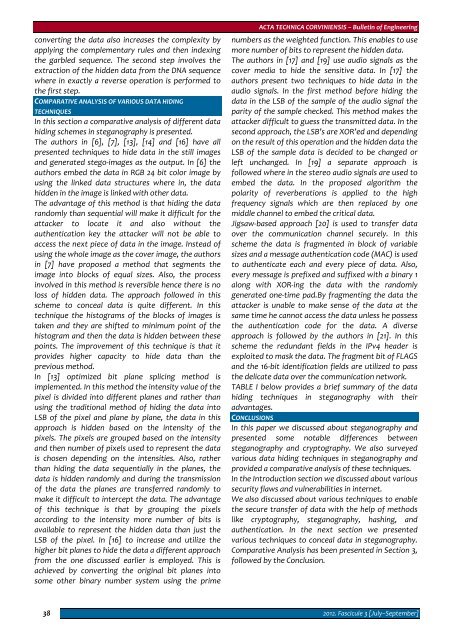1 - Acta Technica Corviniensis
1 - Acta Technica Corviniensis
1 - Acta Technica Corviniensis
You also want an ePaper? Increase the reach of your titles
YUMPU automatically turns print PDFs into web optimized ePapers that Google loves.
converting the data also increases the complexity byapplying the complementary rules and then indexingthe garbled sequence. The second step involves theextraction of the hidden data from the DNA sequencewhere in exactly a reverse operation is performed tothe first step.COMPARATIVE ANALYSIS OF VARIOUS DATA HIDINGTECHNIQUESIn this section a comparative analysis of different datahiding schemes in steganography is presented.The authors in [6], [7], [13], [14] and [16] have allpresented techniques to hide data in the still imagesand generated stego‐images as the output. In [6] theauthors embed the data in RGB 24 bit color image byusing the linked data structures where in, the datahidden in the image is linked with other data.The advantage of this method is that hiding the datarandomly than sequential will make it difficult for theattacker to locate it and also without theauthentication key the attacker will not be able toaccess the next piece of data in the image. Instead ofusing the whole image as the cover image, the authorsin [7] have proposed a method that segments theimage into blocks of equal sizes. Also, the processinvolved in this method is reversible hence there is noloss of hidden data. The approach followed in thisscheme to conceal data is quite different. In thistechnique the histograms of the blocks of images istaken and they are shifted to minimum point of thehistogram and then the data is hidden between thesepoints. The improvement of this technique is that itprovides higher capacity to hide data than theprevious method.In [13] optimized bit plane splicing method isimplemented. In this method the intensity value of thepixel is divided into different planes and rather thanusing the traditional method of hiding the data intoLSB of the pixel and plane by plane, the data in thisapproach is hidden based on the intensity of thepixels. The pixels are grouped based on the intensityand then number of pixels used to represent the datais chosen depending on the intensities. Also, ratherthan hiding the data sequentially in the planes, thedata is hidden randomly and during the transmissionof the data the planes are transferred randomly tomake it difficult to intercept the data. The advantageof this technique is that by grouping the pixelsaccording to the intensity more number of bits isavailable to represent the hidden data than just theLSB of the pixel. In [16] to increase and utilize thehigher bit planes to hide the data a different approachfrom the one discussed earlier is employed. This isachieved by converting the original bit planes intosome other binary number system using the primeACTA TECHNICA CORVINIENSIS – Bulletin of Engineeringnumbers as the weighted function. This enables to usemore number of bits to represent the hidden data.The authors in [17] and [19] use audio signals as thecover media to hide the sensitive data. In [17] theauthors present two techniques to hide data in theaudio signals. In the first method before hiding thedata in the LSB of the sample of the audio signal theparity of the sample checked. This method makes theattacker difficult to guess the transmitted data. In thesecond approach, the LSB’s are XOR’ed and dependingon the result of this operation and the hidden data theLSB of the sample data is decided to be changed orleft unchanged. In [19] a separate approach isfollowed where in the stereo audio signals are used toembed the data. In the proposed algorithm thepolarity of reverberations is applied to the highfrequency signals which are then replaced by onemiddle channel to embed the critical data.Jigsaw‐based approach [20] is used to transfer dataover the communication channel securely. In thisscheme the data is fragmented in block of variablesizes and a message authentication code (MAC) is usedto authenticate each and every piece of data. Also,every message is prefixed and suffixed with a binary 1along with XOR‐ing the data with the randomlygenerated one‐time pad.By fragmenting the data theattacker is unable to make sense of the data at thesame time he cannot access the data unless he possessthe authentication code for the data. A diverseapproach is followed by the authors in [21]. In thisscheme the redundant fields in the IPv4 header isexploited to mask the data. The fragment bit of FLAGSand the 16‐bit identification fields are utilized to passthe delicate data over the communication network.TABLE I below provides a brief summary of the datahiding techniques in steganography with theiradvantages.CONCLUSIONSIn this paper we discussed about steganography andpresented some notable differences betweensteganography and cryptography. We also surveyedvarious data hiding techniques in steganography andprovided a comparative analysis of these techniques.In the Introduction section we discussed about varioussecurity flaws and vulnerabilities in internet.We also discussed about various techniques to enablethe secure transfer of data with the help of methodslike cryptography, steganography, hashing, andauthentication. In the next section we presentedvarious techniques to conceal data in steganography.Comparative Analysis has been presented in Section 3,followed by the Conclusion.382012. Fascicule 3 [July–September]
















